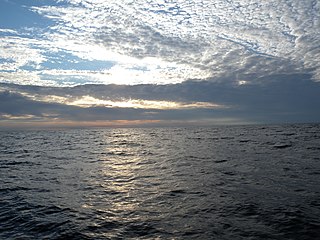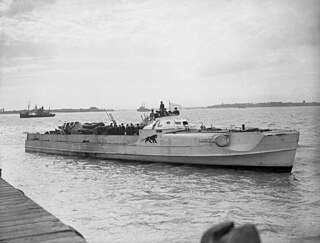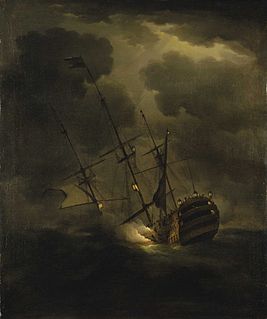
The Celtic Sea is the area of the Atlantic Ocean off the south coast of Ireland bounded to the east by Saint George's Channel; other limits include the Bristol Channel, the English Channel, and the Bay of Biscay, as well as adjacent portions of Wales, Cornwall, Devon, and Brittany. The southern and western boundaries are delimited by the continental shelf, which drops away sharply. The Isles of Scilly are an archipelago of small islands in the sea.

E-boat was the Western Allies' designation for the fast attack craft of the Kriegsmarine during World War II. The most popular, the S-100 class, were very seaworthy, heavily armed and capable of sustaining 43.5 knots, briefly accelerating to 48 knots.

SAS Mendi (F148) is the last of four Valour-class frigates built for the South African Navy by the European South African Corvette Consortium and entered service in March 2007. SAS Mendi was named by Mrs Helena Retief, wife of the (then) Chief of the Navy Vice Admiral Johan Retief.

The Second Battle of Dover Strait was a naval battle of the First World War, fought in the Dover Strait in April 1917 and should not be confused with the major Battle of Dover Strait in 1916. Two Royal Navy destroyers defeated a superior force of German Kaiserliche Marine torpedo boats

HMS Victory was a 96-gun second-rate ship of the line of the Royal Navy, built to the dimensions of the 1733 proposals of the 1719 Establishment at Portsmouth Dockyard, and launched on 23 February 1737.

Frost Glacier is a channel glacier flowing to the head of Porpoise Bay, Antarctica. It was delineated from air photos taken by U.S. Navy Operation Highjump (1946–47), and named by the Advisory Committee on Antarctic Names for John Frost, boatswain on the brig Porpoise of the United States Exploring Expedition (1838–42) under Charles Wilkes.

The Channel Fleet and originally known as the Channel Squadron was the Royal Navy formation of warships that defended the waters of the English Channel from 1854 to 1909 and 1914 to 1915.

Amherstburg Royal Naval Dockyard was a Provincial Marine and then a Royal Navy yard from 1796 to 1813 in Amherstburg, Ontario, situated on the Detroit River. The yard comprised blockhouses, storehouses, magazine, wood yard and wharf. The yard was established in 1796 to support the Upper Canada Provincial Marine after Great Britain ceded a pre-existing shipyard on the Detroit River to the United States. Amherstburg Royal Naval Dockyard constructed four warships for the Lake Erie detachment of the Provincial Marine before and during the War of 1812. In 1813 the dockyard was abandoned and destroyed when the British retreated and never reopened. In 1928, the site was designated a National Historic Site of Canada.

Underwood Glacier is a channel glacier in Wilkes Land, Antarctica about 15 nautical miles long, flowing to the Antarctic coast between Reist Rocks and Cape Nutt. It was mapped in 1955 by G. D. Blodgett from aerial photographs taken by U.S. Navy Operation Highjump in 1947 and named by Advisory Committee on Antarctic Names (US-ACAN) after Lieutenant Thomas Joseph Underwood, Jr., USMC, who served on the sloop Vincennes of the United States Exploring Expedition (1838–42) under Lieutenant Charles Wilkes.

Putative G-protein coupled receptor 42 is a protein that in humans is encoded by the GPR42P gene.

Adams Glacier, also known as John Quincy Adams Glacier, is a broad channel glacier in Wilkes Land, Antarctica which is over 20 miles (32 km) long. It debouches into the head of Vincennes Bay, just east of Hatch Islands. It was first mapped in 1955 by G.D. Blodgett from aerial photographs taken by U.S. Navy Operation Highjump (1947), and it was named by the Advisory Committee on Antarctic Names (US-ACAN) for John Quincy Adams, sixth President of the United States. Adams was instrumental while later serving as U.S. representative from Massachusetts in gaining congressional authorization of the United States Exploring Expedition (1838–42) under Lieutenant Charles Wilkes, and perpetuating the compilation and publication of the large number of scientific reports based on the work of this expedition.

Duxbury Bay is a bay on the coast of Massachusetts in the United States. The west shore of the bay is the town of Duxbury, Massachusetts; and the bay is formed by a sandbar called The Gurnet extending southeasterly from Marshfield, Massachusetts into Cape Cod Bay. The town of Marshfield was named for the estuarine wetland at the north end of the bay. The bay opens southerly toward Plymouth, Massachusetts between Captains Hill to the west and Saquish Head to the east.

Dibble Glacier in Antarctica is a prominent channel glacier flowing from the continental ice and terminating in a prominent tongue at the east side of Davis Bay. It was delineated from air photos taken by U.S. Navy Operation Highjump (1946–47), and named by the Advisory Committee on Antarctic Names for Jonas Dibble, ship's carpenter on the sloop Peacock of the United States Exploring Expedition (1838–42) under Charles Wilkes. Dibble is credited with leaving his sick bed and working 24 hours without relief with other carpenters to repair a broken rudder on the Peacock, when the ship was partially crushed in an ice bay in 151°19′E and forced to retire northward.

Gilchrist Glacier is a short channel glacier flowing to Budd Coast 9 nautical miles (17 km) northwest of Fox Glacier. Delineated by G.D. Blodgett (1955) from aerial photographs taken by U.S. Navy Operation Highjump (1946–47). Named by Advisory Committee on Antarctic Names (US-ACAN) after Dr. Edward Gilchrist, Acting Surgeon on the sloop Wilkes.

Robinson Glacier is a channel glacier flowing to the Antarctic coast between Merritt Island and Reist Rocks. It was mapped in 1955 by G.D. Blodgett from air photos taken by U.S. Navy Operation Highjump (1946–47), and was named by the Advisory Committee on Antarctic Names (US-ACAN) for R.P. Robinson, Purser's Steward of the ship Vincennes on the United States Exploring Expedition under Lieutenant Charles Wilkes, 1838-42.
HMS Nyasaland (K587) was a Colony-class frigate of the United Kingdom that served during World War II. She originally was ordered by the United States Navy as the Tacoma-class patrol frigate USS Hoste (PF-83) and was transferred to the Royal Navy prior to completion.
HMS Tyler (K576) was a British Captain-class frigate of the Royal Navy in commission during World War II. Originally constructed as a United States Navy Buckley class destroyer escort, she served in the Royal Navy from 1944 to 1945.

The Quidora was one of four torpedo boats built in Spain for the Chilean Navy since 1962, based originally in the Jaguar-class fast attack craft FPB-36 design of the German Lürssen Werft. Her sister ship Fresia PTF-81 is now a museum ship in Punta Arenas.

HMS Melbreak was a Hunt-class destroyer of the Royal Navy. She was a member of the third subgroup of the class, and saw service in the Second World War. All the ships of this class were named after British fox hunts. She was the first Royal Navy warship with this name, after the Melbreak hunt in Cumbria. In 1942 she was adopted by the civil community of Cockermouth in Cumberland, as part of Warship Week.













